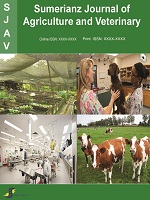Sumerianz Journal of Agriculture and Veterinary

Online ISSN: 2617-3077
Print ISSN: 2617-3131
Quarterly Published (4 Issues Per Year)
Journal Website: https://www.sumerianz.com/?ic=journal-home&journal=30Archive
Volume 4 Issue 2 (2021)
Practices of Medicinal Plants Used By the Local Peoples in Veterinary Medicine in Lohagara Upazila of Narail District, Bangladesh
Authors : Lalita Biswas ; A. H. M. Mahbubur Rahman
DOI : doi.org/10.47752/sjav.42.69.75
Abstract:Purpose: The current investigation is aimed at medicinal plants used by the local people in veterinary medicines in Lohagara Upazila of Narail district, Bangladesh. Methodology: The present study was carried out from November 2018 to March 2020. Practices of veterinary medicinal data were documented following semi-structured questionnaires, field observations and interviews with housewives, cattle owners, and traditional healers and elderly persons. Results: In the research area, a total of 17 veterinary preparations were studied in which 34 medicinal plant species belonging to 29 genre and 22 families were documented. Conclusion: The present researches were preliminary veterinary practice methods and their ordinary utilization.
Pharmacological Effects of Sacred Oils Belonging to Ancient Civilizations
Authors : Baraa Al-mansour
DOI : doi.org/10.47752/sjav.42.55.68
Abstract:Over the centuries, humanity has known and utilized some sacred oils extracted from their medicinal plants for therapeutic purpose. They are considered as good source of bioactive compounds having a wide range of vital biological activities. Aromatic oils have been a part of human history for more than 3,500 years BC and appeared with regularity throughout all major civilizations down the ages, with uses ranging from religious ritual, food flavoring, medicines, perfumery and the masking of bad odors. It is impossible to date exactly when plants were first used medicinally, since such a development would have taken place over thousands of years. During recent decades, many researchers have investigated the mechanisms of action and the therapeutic use of essential oils as physical, emotional, and spiritual well-being. This review, highlights on some sacred essential oils extracted from important traditional medicinal plants that possesses several pharmacological properties, considering that the safety and versatility of this these supplement should allow for its use in numerous pathological conditions.
Behavioural Responses and Mortality of Clarias gariepinus Juveniles Exposed to Acute Concentrations of Paraquat
Authors : Okey I. B. ; Ayotunde E. O. ; Patrick B. U.
DOI : doi.org/10.47752/sjav.42.49.53
Abstract:Paraquat is the most common contact and non- selective herbicide for exterminating vegetative pest. Fish are ideal sentinels for detecting aquatic pollutants and are largely used as bio indicators of environmental pollution. This study is aimed to determine the behavioural changes, lethal concentrations (LCs) and mean lethal time (MLT) of paraquat exposed to Clarias gariepinus. A 96 hours renewable bioassay was conducted with various paraquat concentrations 0.0, 0.25, 0.50, 0.75, 1.0 and 1.25 mg/l. Behavioural changes and cumulative mortality were observed and recorded at 12, 24, 48, 72 and 96 hour. Behavioural changes such as air gulping, erratic swimming, loss of balance, excessive mucus secretion, discolouration and death were observed with severity increasing as concentration and duration of exposure increases. The LC50 values were decreased from 0.191mg/l (0.171 – 0.222) in 12 hour to 0.107mg/l (0.065 – 0.150) in 96 hour, while relative toxicity factor (TF) was increased from 1 to 1.79 times respectively. The 96hr MLT values were decreased from 91.18 hours (54.09-105.64) at the lowest concentration to 16.22 hours (9.06 – 25.15) at the highest concentration with relative toxicity time (RTT) increasing from 1 to 5.62 times. Herbicide should be apply with caution and studies on the sub lethal effects of paraquat on the haematological, biochemical and histological parameters of C. gariepinus juveniles will be necessary.


